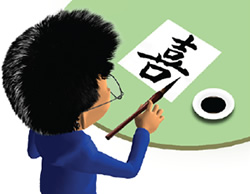People have communicated by writing letters for a long time. Now that we have the internet and mobile phones, it is not as popular as it used to be, but people still get excited when they receive a letter in the mail.
The history of communication

Communication is a very important part of our lives. Over time, humans have tried and tested many different ways to communicate. Some have been a success and some have not.
Read below to find out about the history of communication.
- The alphabet that we use today (the modern English alphabet) was only completed in the 16th century when ‘w’ became an independent letter and ‘u’ and ‘j’ were added. You might think that this still makes it a really old alphabet, but the Egyptian hieroglyphics (a type of picture alphabet) dates back to 3000 BC. Now that is an old alphabet.
- Before paper was invented by the Chinese in 105 AD, people drew on cave walls or wrote on stone tablets, bark, pottery, or papyrus (an older type of paper made from the papyrus plant).
- Before pens and pencils, people wrote with sharpened bones or sticks, or feather quills dipped in ink.
- In the 1440s a German man named Johannes Gutenberg invented the printing press. This was an exciting invention because it meant that books, newspapers and other printed materials could be printed quickly and easily and lots of people could read them.
- Throughout history messages have been delivered in some unusual ways:
- by messengers on foot or on horseback
- by smoke signal
- by pigeons, dogs, camels and even reindeer.
- People who are blind or visually impaired can use Braille (a series of bumps which can be ‘read’ by touch) to read. This system of communication is named after its inventor; a Frenchman named Louis Braille.
- Many ancient civilisations, used oral (spoken) communication to tell stories, myths and legends. We still do this today by reciting nursery rhymes, telling jokes and singing lullabies.
- Today there are lots of different ways to communicate including letters, email and text messages.
Letter writing fast facts

- Throughout history, famous figures, such as the famous composer Ludwig Van Beethoven, the author Ernest Hemingway and King Henry VIII, have put pen to paper and written letters.
- Envelopes are not just for letters. In China, on special occasions, such as weddings or Chinese New Year, people give money in bright red envelopes decorated with gold Chinese letters.
- In the past, paper cost a lot of money, so instead of using an envelope, people would fold their letters and seal them with wax.
- The first envelopes were made by the ancient Babylonians (people from the ancient land of Babylonia) about 5000 years ago. They did not have paper so they were made from baked clay.
- In the past, envelopes were cut from sheets of paper and sealed by hand. Now, we have machines that can make large numbers of envelopes very quickly.
- In the Middle Ages, very few Europeans (people from Europe) could read or write. In fact, the only people who could were monks and members of rich or royal families.

- Calligraphy is a beautiful style of writing practiced in Japanese, Arabic and many other cultures. In these cultures, calligraphy can be linked to spirituality and harmony.
References
The following link will direct you to the homepage of the website used as reference for this topic.
- Australia Post: auspost.com.au




